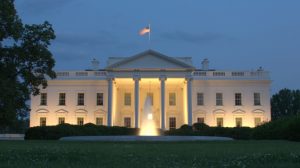The First 100 Days. Now What?
 In one way, the United States has been a very stable place for decades. We’ve only had four Presidents in 24 years. They each got their First 100 Days. Now it’s time to focus the lens on our newest POTUS. What has he actually done, and can investors learn anything from it?
In one way, the United States has been a very stable place for decades. We’ve only had four Presidents in 24 years. They each got their First 100 Days. Now it’s time to focus the lens on our newest POTUS. What has he actually done, and can investors learn anything from it?
Why The First 100 Days
It’s a political cliché that almost everything a President accomplishes is set in motion in the first 100 days of his administration. After 100 days, it’s just fight, fight, grind, grind. The cliché is largely true, and the execution on almost anything takes much longer than 100 days. For example, Obamacare didn’t pass until 2010, nearly 800 days after President Obama took office. The First 100 Days sets the tone. The pace can vary.
What He Said, What He Did
It’s hard to know President Trump’s intentions, so we’ll focus on the overlap of his words and deeds instead. The three main 100 Day events have been:
- A Supreme Court Justice confirmation – back to 9 members again, odd numbers improve bench performance
- Health Care Reform – tried, abandoned, maybe trying again,
- Tax Reform – like health care, it’s on again, perhaps delayed, stay tuned
How Hard Can It Be?
When you dig into the dollars and the math of the Federal budget you see that it’s very hard to change the course of government spending quickly through government action. Every President has expressed great frustration with the slow pace and meager progress. So has Congress. The President often blames Congress, and Congress blames the President.
Why is change so hard? For one simple reason: mandatory spending. Health insurance including Medicare takes 28% of the dollars, Social Security 24%, and the military 15%. That’s two-thirds of the almost $4trillion budget. Mandatory spending explains why the US is sometimes called a big insurance company with a standing army inside it’.
How Can You Really Know?
Markets are very quick to discount news, real or not. The Trump Bump and the Trump Reflation Trade are both long gone. So is the Infrastructure Boom. The Trump Collapse didn’t happen.
Anyone hoping to make big money by buying or selling based on policy announcements, executive orders, military actions or tweets has most likely failed. Politically driven market moves tend to happen in minutes, not days, and many of them unwind quickly. It turns out that headlines are poor predictors of future market performance and a poor basis for portfolio changes.
There’s more action and inaction to come. The government will run out of money on April 29th, and now there are only 55 Congressional working days until its six-week summer recess. It’s practically October…
Turn Down the Noise
Here at Osbon Capital we are highly aware of the chatter and we are not political pundits and prognosticators. In fact, much of the daily political rhetoric impact can be priced through the stock, bond, forex and commodity markets. We have set up a sturdy group of auto-indicators for real-time observation. We do that to stay ‘investment always-on’, so our clients don’t have to fret, worry, or anguish over what daily politics means for their long-term investment portfolios.
Next Steps
It’s now certifiably true that investors and people in general are very worried about the political situation in the US, anti-Trump and pro-Trump alike. There seems to be too little middle ground and too much ‘it’s always darkest before it turns pitch black’ and ‘last chance to get great!’. The anxiety level is noticeably high, tending even to outright fear.
It IS possible to invest through this era of anxiety. At Osbon we do it with the help of significant investments in technology and systems, a deep bench of experts, and lots of conversation to make sure we understand and match client goals with client portfolios. It ain’t easy, and that’s why we do it.
John Osbon – josbon@osboncapital.com
Weekly Articles by Osbon Capital Management:
"*" indicates required fields

